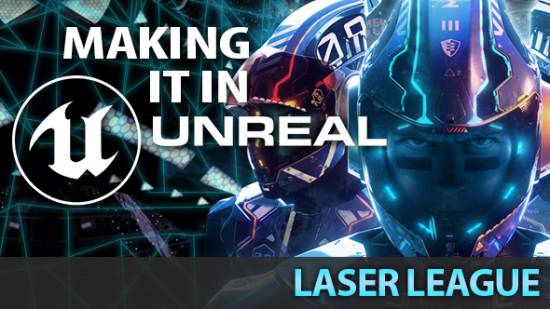Laser League is a game about dodging laser traps and projectiles in a neon arena. Your aim is simply to last as long as you can and make sure your opponents trip up first. It’s intense and precise, with sharp edges reminiscent of Asteroids. Despite the 3D graphics, it looks like it could belong on a coin-op machine in the ‘80s.
Related: the best indie games on PC.
But nailing that arcade simplicity has been tough for OlliOlli developers Roll7. Exactly how do you get a glowing, emissive arena to look precise? And how intense is too intense? As it turns out: somewhere around the point a game starts keeping up you up all night, even after you’ve stopped playing it.
The path to Unreal
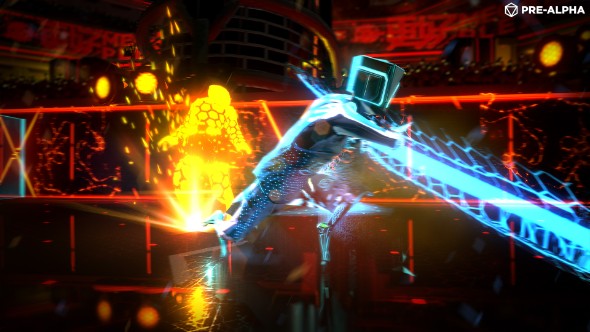
Originally, Laser League was named Cosmic Ultra-Neon Tactics. “We thought it’d be clever because the press wouldn’t be able to abbreviate it, but actually it was childish and stupid,” studio director Simon Bennett tells us.
Back then, it was prototyped in Multimedia Fusion, the same tool the team had used to test out their best-loved game, OlliOlli. “As a prototyping tool, you can have an idea and have some version of it running in, like, a day,” creative director John Ribbins says. “But for a longer-term big project, it’s totally unviable.”
He speaks from experience: Roll7 used Fusion to build the entirety of their side-scrolling shooter Not A Hero, and “pushed the engine to the edge of what it was capable of doing.” For Laser League, they knew they needed something different: first working with Unity, before hopping over to Unreal Engine 4.
“When it came to synchronous multiplayer capabilities, if our game was to live or die by how well the online component was going to work, then we needed to look at Unreal,” Bennett explains. “None of us had any experience whatsoever. But now that we are in Unreal, the power of its lighting engine and some things that it’s got straight out the box has really become apparent.”
A healthy glow
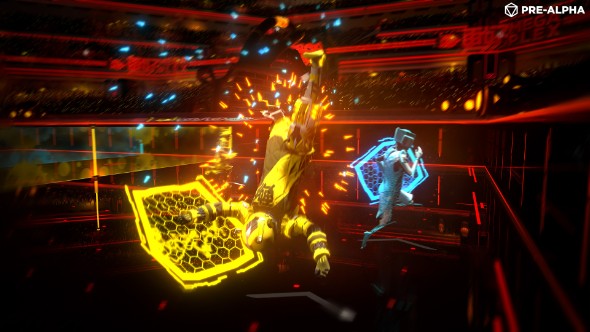
The first time Roll7 allowed themselves to talk about what their dream version of Laser League would be, they were in France for Paris Games Week, and slightly drunk. “Let’s do something massive in 3D,” they thought. “Push ourselves way beyond anything we’ve ever done.”
“One of the criticisms that had always been levelled at our titles was graphic fidelity,” Ribbins notes. “OlliOlli 1 [only] appeals to people who are into pixel art games, as did Not A Hero. There were people who thought OlliOlli 2 looked like a mobile game. With Laser League, [we wanted] 3D sporty dudes, actual laser walls, and huge, futuristic stadiums.”
While the technical team worked to port their prototype into Unreal, the rest of Roll7 knuckled down on the art style – landing on a neon aesthetic somewhere between a Daft Punk music video, a GoPro advert, and Tron.
The studio soon made good use of Unreal Engine 4’s support for shaders. Shaders are the tools that enable the creation of complex light, darkness, colour, and effects work in games – everything from bloom to cel-shading. In Unreal, a simple interface allows developers to build these effects by linking nodes together.
“We have a lot of glowing materials, emissive stuff, and particle effects going on,” Ribbins says. “And so the way that you build materials and shaders in Unreal gave us a lot of opportunity to easily tweak effects live in-game. It makes it easier to play and be creative with what is actually a very technical process otherwise.”
There has been a lot of tweaking. In a game as pixel-precise as Laser League, it’s essential that the stadium remains distinct and readable at all times.
“That’s the biggest challenge on the art direction side,” Ribbins says. “Making something that looks really cool, while not being so cool that it overshadows everything else on the pitch.”
“It’s how you can still make it bombastic and exciting and fast, but ultimately still make out shapes and not be playing something that’s very visually confusing,” Bennett expands. “It’s a refinement process that is probably not going to end for us.”
10% slower, 100% better
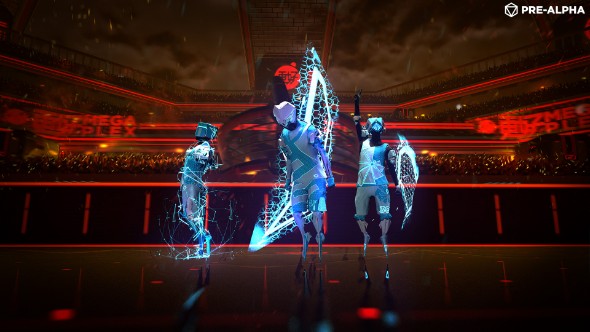
Taking Laser League’s multiplayer online has introduced some intriguing new problems. Beforehand, input lag and human perception were the only factors influencing reaction times and perfect moves. Now, Roll7 had to worry about network lag too.
“We actually had a point recently where we were looking at some of the higher level mechanics of the game, and the time a player had to realise that a situation was going to happen and react to it with a counter,” Bennett recalls. “And that was so close to [the limits of] human perception, that network lag on top made it frequently impossible to do.
“Laser League is actually a little bit slower than it would be if we were just making a local game, but it’s just as challenging to a player online because they have these other factors of lag that we need to account for in our design.”
A few months ago, after a testing session in Devon, players reported that they had trouble sleeping – such was Laser League’s intensity.
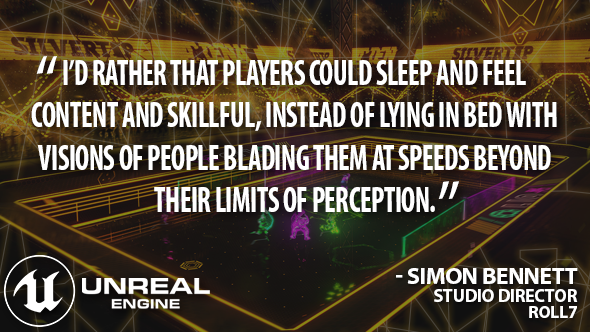
“Rad,” Ribbins laughs at the memory. “We’ve made crack!”
But the developers realised that Laser League’s speed had pushed the game into a realm where it was no longer fun. So they slowed it down by 10%.
“There’s a point where the game blows your mind,” Bennett explains. “And possibly not in a good way.”
They’ve since tested again with the same group of people, with less frightening results.
“At the end of the session they said, although it was still very intense, they weren’t in that same jacked up, amphetamine phase they were when they first played it,” Bennett says. “They felt far more in control of what was going on in the game. I’d rather that they could sleep and feel content and skillful, instead of lying in bed with visions of people blading them at speeds beyond their limits of perception.”
Laser League is currently available through Steam Early Access. Unreal Engine 4 is now free.
In this sponsored series, we’re looking at how game developers are taking advantage of Unreal Engine 4 to create a new generation of PC games. With thanks to Epic Games and Roll7.
